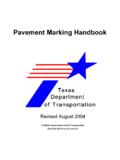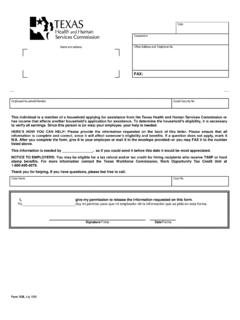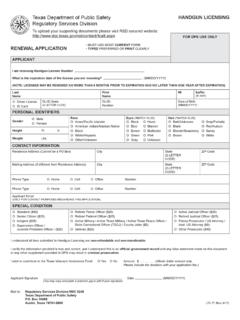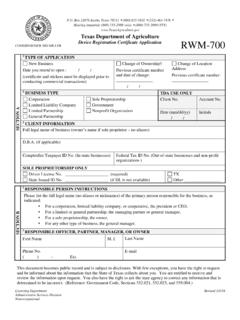Transcription of Title 37 Public Safety and Corrections Part 11 Texas ...
1 Texas Administrative Code Title 37 public safety and corrections part 11 Texas Juvenile Justice department Chapter 341 General Standards for Juvenile Probation Departments Subchapter A. Definitions and General Provisions Subchapter G. Restraints Definitions Applicability Waiver or Variance to Standards Requirements Prohibitions Subchapter B. Juvenile Board Responsibilities Documentation Administration Personal Restraint Policies and Procedures Mechanical Restraint Residential Placement Transporting Subchapter C. Chief Administrative Officer Subchapter H. Carrying of Weapons Responsibilities Applicability and Authorization Policy and Procedure Manual Documentation Requirements Participation in Community Resource Responsibilities of a Juvenile Coordination Groups Probation Officer Authorized to Carry a Firearm Subchapter D. Requirements for Juvenile Responsibilities of Chief Probation Officers Administrative Officers or Other Supervising Officers Duties of Certified Juvenile Probation Written Policies and Procedures Officers Reporting Use of Force Incidents to Duties of Certified Community Activities TJJD and Law Enforcement Officers Records Supervising and Transporting Juveniles Subchapter E.
2 Case Management Mental Health Screening Risk and Needs Assessment Case Management Policies and Procedures Case Plans Subchapter F. Data Collection Data Coordinator TJJD EDI Extract Accuracy of Data Security of Data 37 TAC Chapter 341 Page 1 of 19. 2/1/18 Revision 37 TAC Chapter 341. Subchapter A. Definitions and General Provisions Definitions Effective Date: 2/1/18. The following words and terms have the following meanings when used in this chapter unless the context clearly indicates otherwise. (1) Alternative Referral Plan--A procedure that deviates from the requirements of Texas Family Code (d) regarding referral of cases to the prosecutor. (2) Approved Personal Restraint Technique ("personal restraint")--A professionally trained, curriculum-based, and competency-based restraint technique that uses a person's physical exertion to completely or partially constrain another person's body movement without the use of mechanical restraints.
3 (3) Approved Mechanical Restraint Devices ("mechanical restraint")--A professionally manufactured and commercially available mechanical device designed to aid in the restriction of a person's bodily movement. The only mechanical restraint devices approved for use are the following: (A) Ankle Cuffs--Metal band designed to be fastened around the ankle to restrain free movement of the legs. (B) Handcuffs--Metal devices designed to be fastened around the wrist to restrain free movement of the hands and arms. (C) Plastic Cuffs--Plastic devices designed to be fastened around the wrists or legs to restrain free movement of hands, arms, or legs. Plastic cuffs must be designed specifically for use in human restraint. (D) Soft Restraints--Non-metallic wristlets and anklets used as stand-alone restraint devices. These devices are designed to reduce the incidence of skin, nerve, and muscle damage to the subject's extremities.
4 (E) Waist Belt--A cloth, leather, or metal band designed to be fastened around the waist and used to secure the arms to the sides or front of the body. (4) Case Management System--A computer-based tracking system that provides a systematic method to track and manage juvenile offender caseloads. (5) Chief Administrative Officer--Regardless of Title , the person hired by a juvenile board who is responsible for oversight of the day-to-day operations of a juvenile probation department , including the juvenile probation department of a multi-county judicial district. (6) Comprehensive Folder Edit--A report generated in the Caseworker or Juvenile Case Management System (JCMS) application that performs an extensive edit of the case file information. This report identifies incorrectly entered data and questionable data that impact the accuracy of the reports and programs. (7) Criminogenic Needs--Issues, risk factors, characteristics, and/or problems that relate to a person's risk of reoffending.
5 (8) Data Coordinator--A person employed by a juvenile probation department who is designated to serve and function as the primary contact with TJJD on all matters relating to data collection and reporting. (9) department --A juvenile probation department . (10) Draw--To unholster a weapon in preparation for use against a perceived threat. (11) EDI Specifications--A document developed by TJJD outlining the data fields and file structures that each juvenile probation department is required to follow in submitting the TJJD EDI extract. 37 TAC Chapter 341 Page 2 of 19. 2/1/18 Revision 37 TAC Chapter 341. (12) Empty-Hand Defense--Defensive tactics through the use of pressure points, releases from holds, and blocking and striking techniques using natural body weapons such as an open hand, fist, forearm, knee, or leg. (13) Field Supervision--Supervision ordered by a juvenile court in accordance with Texas Family Code (d)(1)(A) where the child is placed on probation in the child's home or in the custody of a relative or another fit person.
6 (14) Formal Referral--An event that occurs only when all three of the following conditions exist: (A) a juvenile has allegedly committed delinquent conduct, conduct indicating a need for supervision, or a violation of probation;. (B) the juvenile probation department has jurisdiction and venue; and (C) the office or official designated by the juvenile board has: (i) made face-to-face contact with the juvenile and the alleged offense has been presented as the reason for this contact; or (ii) given written or verbal authorization to detain the juvenile. (15) Initial Disposition--The disposition of probation issued by a juvenile court after a child is: (A) formally referred to a juvenile probation department for the first time; or (B) formally referred to a juvenile probation department after any and all previous periods of supervision by the department have ended. (16) Inter-County Transfer--As described in Texas Family Code , a transfer of supervision from one juvenile probation department in Texas to another juvenile probation department in Texas for a juvenile who moves or intends to move to another county and intends to remain in that county for at least 60 days.
7 (17) Intermediate Weapons--Weapons designed to neutralize or temporarily incapacitate an assailant, such as electronic restraint devices, irritants, and impact weapons. This level of self-defense employs the use of tools to neutralize aggressive behavior when deadly force is not justified but when empty-hand defense is not sufficient. (18) Intern--An individual who performs services for a juvenile justice program or facility through a formal internship program that is sponsored by a juvenile justice agency or is part of an approved course of study through an accredited college or university. (19) Juvenile--A person who is under the jurisdiction of the juvenile court, confined in a juvenile justice facility, or participating in a juvenile justice program. (20) Juvenile Board--A governing board created under Chapter 152 of the Texas Human Resources Code. (21) Juvenile Justice Program--A program or department that: (A) serves juveniles under juvenile court or juvenile board jurisdiction; and (B) is operated solely or partly by the governing board, juvenile board, or by a private vendor under a contract with the governing board or juvenile board.
8 The term includes: (i) juvenile justice alternative education programs;. (ii) non-residential programs that serve juvenile offenders under the jurisdiction of the juvenile court or the juvenile board; and (iii) juvenile probation departments. (22) Professional--a person who meets the definition of professional in of this Title . 37 TAC Chapter 341 Page 3 of 19. 2/1/18 Revision 37 TAC Chapter 341. (23) Resident--A juvenile or other individual who has been lawfully admitted into a pre-adjudication secure juvenile detention facility, post-adjudication secure juvenile correctional facility, or a non- secure juvenile correctional facility. (24) Residential Placement--Supervision ordered by a juvenile court in which the child is placed on probation outside the child's home in a foster home or a Public or private institution or agency. (25) Restraints--Personal or mechanical restraint. (26) Responsivity Factors--Factors that are not necessarily related to criminal activity but are relevant to the way in which the juvenile reacts to different types of interventions ( , learning styles and abilities, self-esteem, motivation for treatment, resistance to change, etc.)
9 (27) SRSXEdit--An audit program developed by TJJD to assist juvenile probation departments not using the Caseworker or JCMS application with verifying their data prior to submission to TJJD. (28) Supervision--The case management of a juvenile by the assigned juvenile probation officer or designee through contacts ( , face-to-face, telephone, office, home, or collateral contacts) with the juvenile, the juvenile's family, and/or other persons or entities involved with the juvenile. (29) TCOLE-- Texas Commission on Law Enforcement. (30) Title IV-E Approved Facility--A facility licensed and/or approved by the Texas department of Family and Protective Services for Title IV-E participation. (31) TJJD-- Texas Juvenile Justice department . (32) TJJD Electronic Data Interchange (EDI) Extract--An automated process to extract and submit modified case records from the department 's case management system to TJJD.
10 The extract must be completed in accordance with this chapter. (33) TJJD Mental Health Screening Instrument--An instrument selected by TJJD to assist in identifying juveniles who may have mental health needs. (34) Volunteer--An individual who performs services for the juvenile probation department without compensation from the department who has: (A) any unsupervised contact with juveniles in a juvenile justice program or facility; or (B) regular or periodic supervised contact with juveniles in a juvenile justice program or facility. Waiver or Variance to Standards Effective Date: 1/1/17. Unless expressly prohibited by another standard, an application for a waiver or variance of any standard in this chapter may be submitted in accordance with of this Title . Subchapter B. Juvenile Board Responsibilities Administration Effective Date: 1/1/17. (a) Local Juvenile Probation Services Administration.











